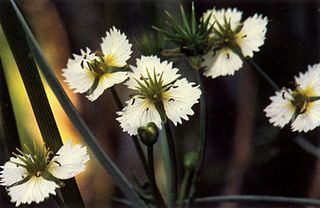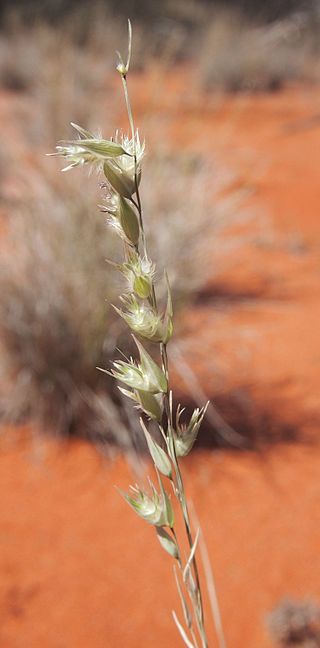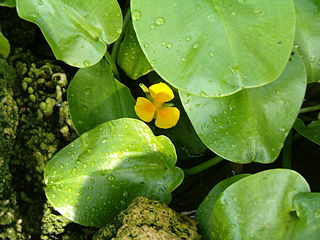
The Alismatales (alismatids) are an order of flowering plants including about 4,500 species. Plants assigned to this order are mostly tropical or aquatic. Some grow in fresh water, some in marine habitats. Perhaps the most important food crop in the order is the taro plant, Colocasia esculenta.

Milla, the Mexican star, is a genus of monocotyledonous plants in the family Asparagaceae, subfamily Brodiaeoideae. They are native mostly to Mexico, with one species extending into Guatemala, Honduras, Arizona, Texas and New Mexico.

Alisma is a genus of flowering plants in the family Alismataceae, members of which are commonly known as water-plantains. The genus consists of aquatic plants with leaves either floating or submerged, found in a variety of still water habitats around the world. The flowers are hermaphrodite, and are arranged in panicles, racemes, or umbels. Alisma flowers have six stamens, numerous free carpels in a single whorl, each with 1 ovule, and subventral styles. The fruit is an achene with a short beak.

The water-plantains (Alismataceae) are a family of flowering plants, comprising 20 genera and 119 species. The family has a cosmopolitan distribution, with the greatest number of species in temperate regions of the Northern Hemisphere. Most of the species are herbaceous aquatic plants growing in marshes and ponds.

Echinodorus, commonly known as burhead or Amazon sword, is a genus of plants in the family Alismataceae, native to the Western Hemisphere from the central United States to Argentina. Its scientific name is derived from Ancient Greek echius – "rough husk" - and doros – "leathern bottle" - alluding to ovaries, which in some species are armed with persistent styles, forming prickly head of fruit. Some of the species are commonly cultivated in artificial aquatic habitats.

Caldesia is a genus of aquatic plants. It includes three living species widespread across Europe, Asia, Africa and Australia. The genus "has an extensive Oligocene through Pleistocene fossil record in Eurasia," and has been found in fossil strata of the United States as well. Ten fossil species have been described for the genus.

Damasonium is a genus of six species of flowering plants in the family Alismataceae, commonly known as starfruit and by the older name thrumwort. The genus has a subcosmopolitan but very patchy distribution.

Limnocharitaceae was a family of flowering plants in the monocot order Alismatales. In the APG IV system, it is included in the family Alismataceae. It is commonly known as the water poppy family. Species that have been placed in this taxon are small, perennial, aquatic herbs, native to the tropics, but adventive or naturalized in the subtropics as a result of cultivation.

Hypolytrum is a genus of plant in the family Cyperaceae. It contains approximately 60–70 species, native to tropical Africa, Asia, Australia, Latin America and various oceanic islands.
Burnatia is a genus in the family Alismataceae. It includes only one currently recognized species, Burnatia enneandra. It is native to tropical and southern Africa from Senegal to Tanzania to South Africa. Among genera of the Alismataceae, it can be distinguished by not having a differentiated perianth, and being dioecious, with male and female flowers on separate individuals. Male flowers have 6 to 9 stamens and female flowers have many carpels and up to 2 staminodia.

Limnophyton is a genus in the family Alismataceae. It includes five species from the Old World tropics. Three species are recognized as of May 2014:
Alismaticarpum alatum is a fossil species of aquatic plants in the family Alismataceae. It is a form taxon created for winged fruits whose precise assignment to a genus is not possible. Fossil fruits of this species are known from the Oligocene of England.
Sagisma is a fossil genus of aquatic plants. It includes two species distributed in Oligocene and Miocene deposits of western Siberia.

Callisia is a genus of flowering plants in the spiderwort family, Commelinaceae. Members of the genus are commonly known as roselings. It is native to the Western Hemisphere from the southern United States to Argentina. The generic name is derived from the Greek word κάλλος (kallos), meaning "beauty."

Monachather, common name mulga oats, is a genus of Australian plants in the grass family.
Butomopsis is a genus of plants in the family Alismataceae. It contains only one species, Butomopsis latifolia. native to tropical Africa, South Asia, Southeast Asia and northern Australia.

Hydrocleys is a genus of aquatic plants in the Alismataceae, native to the Western Hemisphere, though one is naturalized elsewhere and sold as an ornamental for decorative ponds and artificial aquatic habitats. At present, five species are recognized:
Helen Isobel Aston was an Australian botanist and ornithologist.

Astonia III was a fantasy MMORPG video game that was initially released in September 2001. It was developed as a solo project by German programmer Daniel Brockhaus as a sequel to his earlier project, a smaller MMORPG called Mercenaries of Astonia. At the end of the year, Astonia III launched into a full release, and started to charge players a monthly subscription fee, with one-month free trial. In late 2014, the game's official servers were shut down, and its source code was released online by Brockhaus.














